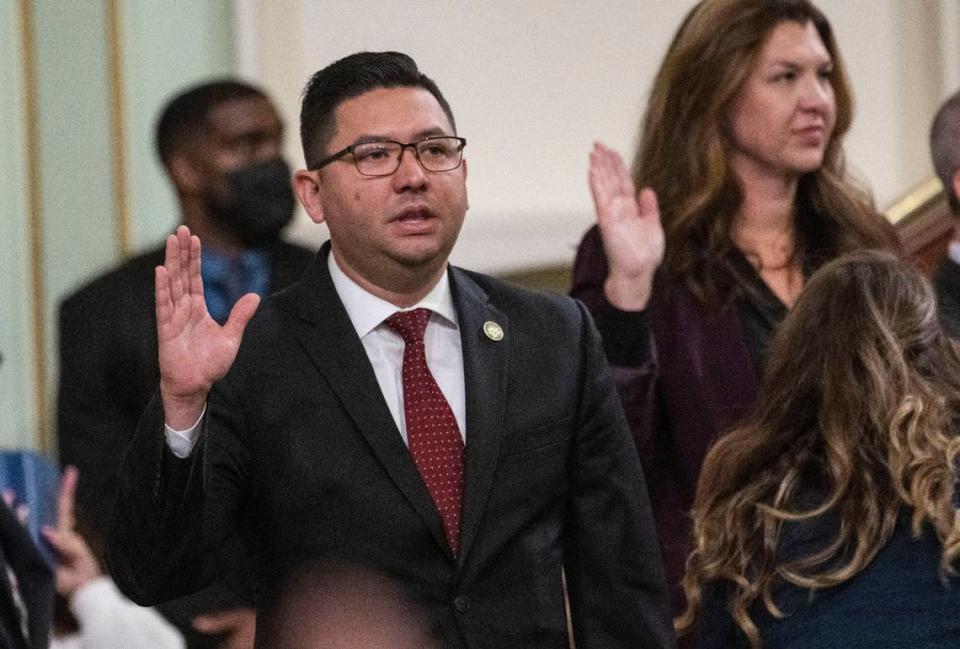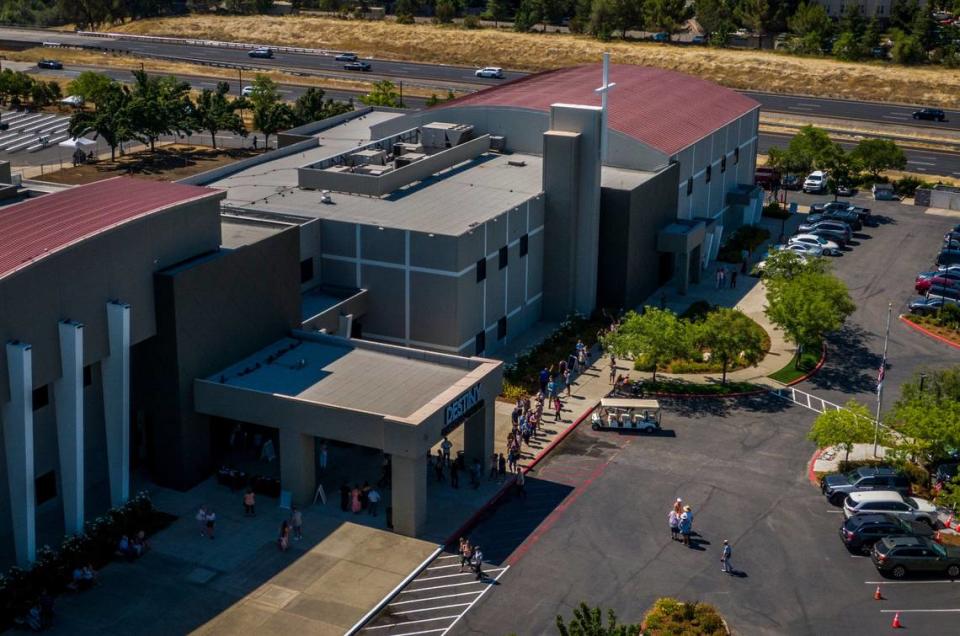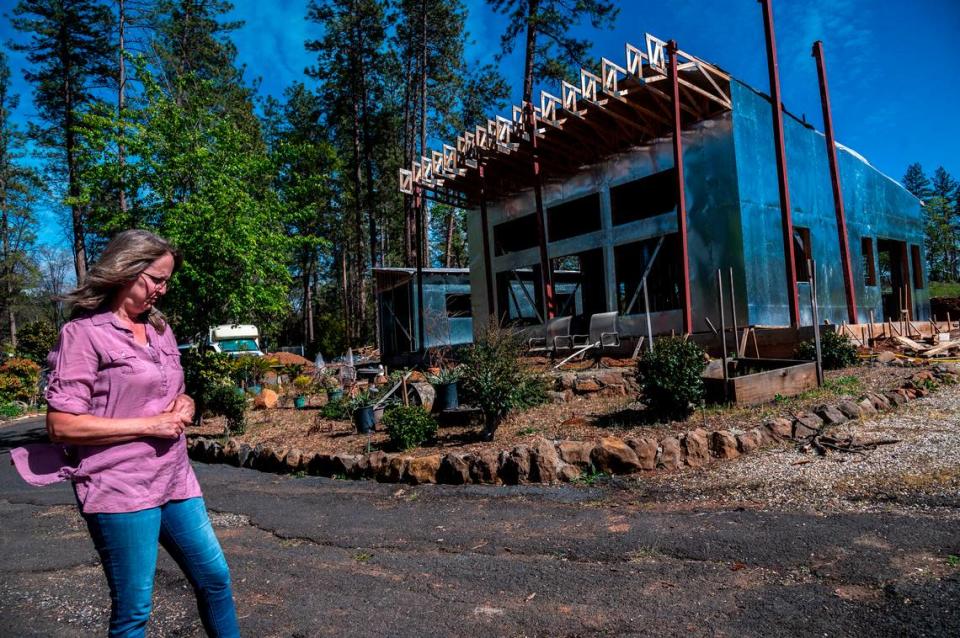The Sacramento Bee’s most memorable journalism of 2022
Every day, journalists at The Sacramento Bee strive to bring you stories that make a difference to you, and help you make a difference in your community.
We take this responsibility to heart — building a better, more-informed Sacramento is at the core of our mission. And it lights a fire under a team of dedicated Bee journalists who are driven to inform, inspire and engage.
With 2022 coming to a close, we asked newsroom editors to share the journalism they worked on that had the most impact — stories that held the powerful to account, taught us more about our neighbors, informed our most important decisions and helped us make the most of everything the Sacramento region has to offer.
These are a few examples of the work that made an impression in 2022. And the work to make a difference in 2023 has already begun.
— Nicole Stockdale, senior managing editor
A mass shooting downtown
One of the worst mass shootings in Sacramento’s history unfolded in the early hours of April 3, when alleged gang rivals opened fire on each other as downtown bars closed for the night. The crossfire and stray bullets took six lives and wounded 12 others.
Our reporters and photographers, led by veteran reporter Sam Stanton, raced to 12th and K streets before sunrise. They found a stunning scene: police collecting more than 100 shell casings from the busy downtown corner as loved ones of victims began looking for answers. One victim, we learned, was a homeless woman caught in the crossfire.
That morning was just the beginning of our coverage.
Stanton broke story after story as law enforcement agencies pieced together what happened. Stanton, Jason Pohl and Dale Kasler investigated the backgrounds of suspects who had been released early from prison sentences, finding they had bounced “from one jail cell to the next” for a decade.
A team of reporters investigated how Sacramento-area gangs have evolved since their violent heyday of the 1990s and early 2000s. We looked at ways bouncers and city police work to keep people safe as nightclubs close. We investigated gun control, Sacramento’s stop-and-start efforts to invest in gang prevention and how the shooting set back the city’s campaign to revive its downtown nightlife district. We stayed with the story throughout the year, including breaking down new Sacramento Police Department tactics that target illegal guns.
Our coverage resulted from our commitment to provide news and information, with urgency and context, even in the most dire circumstances.
— Adam Ashton, assistant managing editor
Amplifying the voices of Change Makers

The Sacramento Bee’s Equity Lab asked readers for help with one of 2022’s most engaging projects: our Change Makers series. We aimed to spotlight people making a difference in the Sacramento region, and we wanted to focus on communities that have been underrepresented and underserved in the past. You delivered — with hundreds of nominations describing people who are making Sacramento a better place by finding solutions for our most difficult challenges.
The Equity Lab, a team of community-funded journalists at The Bee who elevate stories about representation and accountability, knew we couldn’t do this project by ourselves. So we teamed up with the Nehemiah Emerging Leaders Program and volunteer judges to seek out nominations and determine who to recognize.
Those conversations led to our Black Change Makers presentation in February and our AAPI Change Makers edition in October; our Latino Change Makers project is scheduled to publish in January. We’re so grateful that our readers helped us identify and highlight these 75 problem solvers.
— Adam Ashton, assistant managing editor
Uncomfortable truths on homelessness
As the homelessness crisis intensified, Bee columnist Melinda Henneberger uncovered the failings of our social safety net and explored the nuances of neighborhoods and unhoused individuals struggling to coexist in a county where the homeless population has ballooned to just under 9,300 people at last count. Henneberger and photojournalist Renée C. Byer shared the story of the life and death of James Mark Rippee, who was blind, homeless and severely mentally ill. While California spends billions on combating homelessness, Rippee never received the help he needed. And despite his sisters’ tireless efforts to get him treatment and support, Rippee died of multiple organ failure after an untreated urinary tract infection caused sepsis.
Henneberger also laid bare the grim existence in a homeless hell known as “the snake pit,” where rape, meth and mental illness compound the dangers of living on the street. And she investigated the complexities of implementing and enforcing ordinances aimed at both helping the homeless and clearing Sacramento’s sidewalks. In a continuing series of columns, Henneberger has shone a light on the gray areas in the debate about homelessness, detailing the perilous existence of those who are unhoused and digging deeper into public policies that too often haven’t met the needs of the most vulnerable or addressed the concerns of businesses owners and homeowners in close proximity to homeless encampments.
— Marcos Bretón, opinion editor
Leading the state in police chases
Dangerous police chases are on the rise in California — especially in Sacramento, which has seen a number of recent police pursuits end in deadly crashes. Reporters Jason Pohl, Phillip Reese, Ryan Sabalow and Kevin Nguyen dug deeper into why, and discovered that Sacramento policy enables police to undertake pursuits regardless of the severity of the infraction. Their reporting also revealed that Sacramento police give chase at a higher rate than any other big city in California, with a database built by Reese showing how cities’ police pursuit rates compare.
Police chases put innocent bystanders at risk; we thought it was important to show the impact on families who lose a loved one as the result of a pursuit. Kevin made a special effort to tell the story of the children and mother of a couple who were killed as the result of a pursuit, with gripping images from Paul Kitagaki.
The chair of the Sacramento Community Police Review Commission said the bar for police pursuits has to be much higher. And a member of Sacramento’s police commission said pursuit policies would be taken up at an upcoming meeting.
— Alvie Lindsay, California investigations editor, and Emilie Stigliani, senior editor for in-depth journalism
Sacramento’s Top 50 restaurants

Food and drink writer Benjy Egel had a big idea for 2022: He wanted to capture how Sacramento’s dining scene changed after the disruptions caused by the COVID-19 pandemic. That vision propelled him to visit dozens of restaurants all over the Sacramento region, giving him a ground-level look at a celebrity chef pursuing a Michelin star in midtown, entrepreneurs carving out a new scene in Roseville and go-to joints trying fresh approaches in Woodland.
His work culminated last month with The Sacramento Bee’s Top 50 Restaurants. As Egel wrote, “I wanted a Top 50 list that encapsulated the diversity of the Sacramento region’s dining scene. That meant cultural diversity, regional diversity and economic diversity. Expensive doesn’t always mean exceptional, of course.”
He hit his mark, and you’ll want to save that piece for your next night out.
— Adam Ashton, assistant managing editor
The chance for a clean slate

In May, The Sacramento Bee launched Clean Slate, a project to review some online news stories that are making it difficult for subjects to move on with their lives. Too often, people who have committed minor criminal offenses, or have had charges against them dropped, are stymied in their attempts to secure housing, jobs, loans or school admission; an article in search engine results can stop landlords and hiring managers in their tracks, preventing people from having a chance to build a better life.
For each application that has come in, a team of Bee journalists has investigated the facts and weighed a host of options, including updating the story, deindexing the article from search engines or even unpublishing the story altogether. In some cases, we’ve determined that no action is warranted.
The impact has been clear: We’ve offered residents an avenue to keep a minor brush with the law from unfairly becoming a major roadblock to their future. We’re accepting applications here.
— Nicole Stockdale, senior managing editor
Precious water, poor policing

Few Californians fully understand the multi-layered and convoluted system that governs the state’s most precious resource — water. With a fourth year of drought looming, reporters Ryan Sabalow and Dale Kasler launched an investigation into the shortcomings of California’s water governance system, a system unprepared to police the state’s evermore precious water supply.
They found that farmers and other water users frequently ignore state drought regulations, and crackdowns are rare. When they do occur, the fines aren’t much of a deterrent. The day after this investigation published, the water board recommended issuing its maximum fine to a group of farmers that flouted drought regulations, draining a river to fill livestock ponds. The fine amounted to less than $50 per farmer.
The collection of stories got the attention of more than 100,000 readers interested in better understanding how to protect this natural resource. It also attracted the attention of professionals: One conservation lobbyist said the reporting would be used to craft legislative proposals for water policy reforms.
— Alvie Lindsay, California investigations editor, and Emilie Stigliani, senior editor for in-depth journalism
More fuel to feed your football frenzy

The start of the high school football season also brought expanded preps coverage from The Bee, with the launch of the Preps Overtime eEdition. Every Saturday morning, subscribers can dive into an online-only special section filled with stories, up-to-date stats and standings, and dramatic photography from the week’s best games.
When combined with the drumbeat of coverage from reporters Joe Davidson and Chris Biderman, The Bee is the go-to source for preps news from the San Joaquin-Sac region. Our weekly rankings, produced by Davidson, have become the standard that teams measure themselves against in our region. And you play a role, too. Our Prep of the Week polls, which asks readers to choose the week’s best performance, are consistently one of the most popular features on SacBee.com, with millions of votes cast this year.
— Nicole Stockdale, senior managing editor
Informed decisions at the ballot box …

Our editorial board is committed to serving our community during every election cycle by selecting candidates and initiatives we support and explaining those decisions to our readers in endorsement editorials. (These editorials are unsigned and represent the majority view of our editorial board members; they do not reflect the views of our colleagues on the news side of the organization.)
These endorsement editorials aren’t an attempt to predict campaign winners and losers. Rather, we want to help voters make informed decisions about who would be most effective in office. We do this by interviewing statewide and local candidates running for key offices, as well as the supporters and opponents of statewide and local initiatives. In this election cycle, that meant conducting interviews with more than 100 people for endorsements published ahead of the November elections.
We deliberated on each contest as a board, made our selection by majority vote and then collaborated to compose our endorsement editorial. Each of these interviews is videotaped and published online, giving readers a front-row seat in the endorsement process. You can find links to our 44 endorsements here.
— Marcos Bretón, opinion editor
… With reporting that sways votes

Among the editorial endorsements with the greatest impact was our push against Measure A, which would have triggered a 0.5% sales tax to raise at least $8.5 billion for Sacramento County transportation projects.
Despite millions of dollars put up by the most powerful interests in Sacramento, Measure A was soundly defeated at the ballot box. The Bee Editorial Board played an undeniable role in identifying a money grab posing as a citizens’ initiative. Through vigorous Public Records Act requests, we highlighted documents that detailed how the county’s climate goals would be sacrificed to satisfy developers seeking taxpayer dollars to build unsustainable roadways in order to finance their developments. We blew the whistle on the false campaign promises made by Measure A supporters, and we compelled climate experts who had remained quiet to denounce the lies of Measure A proponents.
Measure A was an arcane initiative buried on a ballot loaded with statewide races. It had the support of key players such as Sacramento Mayor Darrell Steinberg. But it was bad for Sacramento. We called it out, and it lost.
— Marcos Bretón, opinion editor
Letting you show off a little
The Sacramento Bee sought to find more ways to help readers engage with the news and our journalists in 2022. One such effort was our weekly Instagram news quiz, where we challenged readers to show off their knowledge about the biggest stories of the week, with a sharp Sacramento focus.
These quizzes complemented the eye-catching photos and videos from our visual journalists that make up the bulk of our Instagram posts, from video real estate tours to weather updates, breaking news, politics and more.
The best part: The more we hear from readers, the better our social media feeds get. We want to hear what’s on your mind — whether you’re looking for the best sushi in Sacramento, an explainer on inflation relief, a favorite karaoke spot, or tips on hiking around Folsom. Drop us a question at instagram.com/sacramentobee (and show us what you’ve got in the news quiz!).
— Nathan Boley, audience growth and development editor
Sherri Papini’s dragnet of lies

Reporters Ryan Sabalow and Sam Stanton wove together a three-part narrative on the fabricated abduction that Sherri Papini orchestrated. The California mom of two went missing for nearly three weeks in 2016 and mysteriously reappeared beside a highway on Thanksgiving Day. She told a story of being abducted by two Latino women. The truth — revealed six years later when she was charged with mail fraud after receiving payments from the victim compensation board — was that she asked an ex-boyfriend to pick her up and then inflicted her own injuries while she stayed with him in Southern California.
This was the first time that the full narrative of Sherri Papini’s story was detailed from start to finish. Sabalow and Stanton also pored over court records to find previously unnamed victims of Papini’s lies — such as an uninvolved male acquaintance who wound up on the suspect list and people whose cellphones pinged towers near where Papini disappeared and reappeared.
— Alvie Lindsay, California investigations editor, and Emilie Stigliani, senior editor for in-depth journalism
Latino influence in the Statehouse

Throughout 2022, reporter Mathew Miranda explored the dynamics of rising Latino power in the Capitol, documenting alliances with labor, California’s expanded safety net for undocumented households and campaigns for new laws meant to help low-wage workers.
Those stories illustrate the influence of Latino Democrats in the Legislature, but Miranda also captured the diversity of viewpoints in California’s Hispanic communities. He joined with colleagues at The Modesto Bee and The Fresno Bee to host an online forum on Latino voting trends ahead of the midterm election, with an emphasis on the rightward trajectory of some Hispanic voters. Now, after that election, Latino Republicans hold four seats in the Legislature, their largest voting bloc in 20 years.
The emergence of more Latino Republicans in the Legislature led to one of Miranda’s most-read stories of 2022: his recent piece on the California Latino Legislative Caucus excluding Republican members.
— Adam Ashton, assistant managing editor
Listening. Listening. Listening.

At its core, service journalism is about upholding our community, and providing our readers with the information they want and need to navigate life — the difficult moments and the exciting ones — in Sacramento. In our first full year, our team has done one thing above all: Listen.
We launched two series this year in hopes of helping you discover and have fun in your community. The first, led by reporter Hanh Truong, answers direct questions from readers about the quirks and curiosities of the region. “Bee Curious” answered more than a dozen questions from you in 2022 (and a big thank you to all who wrote to us). Here are some of our favorites:
Arden Arcade resident Arianna Smith asked: “Why hasn’t the city of Sacramento ever annexed Arden Arcade?”
Monica Ocon, from the San Francisco Bay Area, asked: “Why is the (Tower Bridge) gold, and was it always that color?”
A handful of you wrote to ask us a variation of this reader’s question: “Those two cranes popping up from the ground as you approach or pass Cal Expo? What are they up or down to?
The second series came out of a tough time — and a desire to love our city through it. Reporter Brianna Taylor wanted to feel more connected with Sacramento, but enjoying all the city has to offer can be expensive. In Brianna’s new series, “Sacramento on a Budget,” she explores Sacramento, one $25 activity at a time. More than 20 of you have already written to us with your suggestions for her next activity. Thank you.
In 2022, this team also launched two newsletters, “The Canopy: Living Your Best Life in Sacramento” which features stories from our service journalism reporters: Brianna, Hanh and Jacqueline Pinedo. Every week, we walk you through the top headlines, help you navigate the news and look ahead to the weekend. As one reader put it: The Canopy “keeps me connected and up to date in our community” and helps residents explore places they hadn’t thought of before. You can join us weekly, too. It’s free.
In “New in Sacramento: Guide to the City of Trees,” We walk newcomers looking to discover the city, and locals hoping to reconnect, through need-to-know basics about the region: from transportation to weather, activities and trivia only a local would know. It’s also free, and you can sign up here.
The Bee’s service journalism team received more than 500 questions from readers this year, and our reporters provided important information about changes to our recycling laws, the rollout of California inflation relief checks, and the lifting of COVID-19 restrictions. We appreciate you for trusting us with your worries and interests; there’s more to come in 2023.
— Savanna Smith, service journalism editor
40 years later, unforgotten pain
Reporter Sam Stanton delivered a story he had been working to land for months about two brothers suing their alma mater, Capital Christian High School, over the sexual abuse they allegedly endured at the hands of a teacher four decades ago.
The teacher, who went on to become a professor at a Christian college in the Midwest, groomed them with favors, cash and gifts, luring them to his house to grade papers only to engage them in a wicked “game” in which he tied them up and blindfolded them while he gratified himself sexually by watching them try to escape, they said.
The lingering pain, unsettled for decades, had been resurrected because of a California “look back” law that allowed past sex abuse victims to file civil lawsuits against their abusers.The details came to light only after the brothers agreed to a series of phone calls and Zoom meetings with Stanton before eventually deciding to allow on-the-record, in-person interviews.
Reported and written over two months, Stanton’s examination of the abuse alleged by these brothers and three other men was followed by the teacher leaving his college post the day after publication. The impact of Stanton’s work was on full display as more men came to him with their stories of sexual abuse — nine in all — and others who had suffered sexual abuse as teens came forward to share their stories of pain.
— Daniel Hunt, local news editor
Putting politics in context

Impact isn’t always easy to measure. If a story doesn’t result in a resignation, a new law or an indictment, does that mean it is without impact? No. These three stories represent some of the best of our coverage of the 2022 midterm campaign. They answer what I think is our highest calling: to ensure that voters are in a position to make the most informed choices possible when they cast their ballots.
In Gavin Newsom’s Fair Oaks backyard, proud Democrats are few and far between: Sometimes a story’s impact comes from landing in the midst of a community’s most urgent conversation. That was the case with Jenavieve Hatch’s profile of Gov. Gavin Newsom’s neighborhood, populated by Democrats in the depths of their doubt and despair over the party’s prospects in 2022 and beyond. November was not the catastrophe they feared, but this story reflected the moment.
Gavin Newsom promised to end homelessness as SF mayor. It remains his biggest challenge: Accountability has its own kind of impact — measuring what an incumbent has delivered against what was promised. Gavin Newsom has been the golden child of California politics, but in his 25 years in office, from the San Francisco Board of Supervisors to the governorship, he has repeatedly promised a cure for chronic homelessness. Billions of tax dollars later, the problem is far worse. “Homelessness has cast a long shadow across Newsom’s quarter-century in California politics,” Maggie Angst wrote.
In Placer County, a rising movement to establish a ‘biblical worldview’ in California politics: We had written before about Destiny Church, a popular evangelical Christian church in the Sacramento suburbs founded by Pastor Greg Fairrington. But Jenavieve Hatch started hearing about Fairrington’s aggressive moves into local politics, founding a satellite organization to recruit and finance candidates for school board. It was a brazen melding of church and state. “In Placer County, the biblical and the political have achieved a striking synchronicity,” Hatch wrote.
— Bill Turque, political enterprise editor
Wildfire victims hit with another loss

Since the most destructive wildfire in California history tore through Paradise in 2018, about 1,500 homes and apartments have been rebuilt. But for some wildfire victims, the rebuilding process has made them victims all over again. After a five-month investigation, reporters Ryan Sabalow and Dale Kasler wrote about the bad actors who took money from the Camp Fire victims with the promise of rebuilding their homes. Many months later the money was gone, but the houses never materialized.
Sabalow and Kasler conducted dozens of interviews, reviewed hundreds of pages of court documents and other public records, combed through social media posts and enlisted the help of a retired FBI agent to report this story. The result so far? The victims credited The Bee’s investigation with helping bring this case to the district attorney’s attention. Butte County prosecutors have indicted one of the contractors on charges related to allegations that he had preyed on the wildfire victims.
— Alvie Lindsay, California investigations editor, and Emilie Stigliani, senior editor for in-depth journalism
Why homelessness solutions aren’t working

The housing and homelessness crisis in California is a complex maze of bureaucratic and political failures at the city, county and state levels. It’s not often that one writer can see the entire picture of California’s crisis and explain it in elegant prose, but Deputy Opinion Editor Josh Gohlke did — touching on well-meaning politicians, politically popular unions and a wary public. In a front-page essay mixing exhaustive reporting and superior storytelling, Gohlke took readers on a journey where they learned why homelessness has exploded in California and why the official response to it has not, as Gov. Gavin Newsom likes to say, “met the moment.”
Even though Gohlke’s essay, widely read by officials in Sacramento, is not the reason why the city and county of Sacramento are trying to cooperate like never before, his work certainly explained why they must.
— Marcos Bretón, opinion editor
Snowballing code enforcement citations
City Hall reporter Theresa Clift wanted to know more about a handful of Sacramento homeowners who found themselves facing hundreds of thousands of dollars in fees and penalties stemming from code enforcement citations. She found a link in two of the cases: Judges appointed a company called the Bay Area Receivership Group to fix up the homes, and bills piled up far beyond what the homeowners could pay.
Clift expanded her reporting to examine Bay Area Receivership Group cases in other Northern California communities. Court records showed that the company passes on more administrative charges to homeowners than comparable companies, potentially leaving property owners in crippling debt.
The city of Sacramento initiated its review of receivership companies during Clift’s investigation. We’ll report on those findings as they are released, as well as on the outcomes of the cases we’ve documented so far.
— Adam Ashton, assistant managing editor
Preventing domestic violence tragedies
An unthinkable tragedy unfolded at a Sacramento-area church in February. A father killed his three daughters during a supervised visit. David Mora shot Samia, 13; Samantha, 10; and Samarah, 9, and church chaperone Nathaniel King, 59, before killing himself at The Church of Sacramento.
Our journalists worked through the night to document the violence and the mourning that followed. We connected with students and teachers who noticed the three empty classroom chairs where the Mora children should have been. And, importantly, our team investigated what could be done to prevent the next domestic violence tragedy.
Reporters Sam Stanton, Jason Pohl, Ryan Sabalow and Ariane Lange detailed how abusers like Mora are able to keep guns despite restraining orders that forbid them. Lange explored an aggressive domestic violence prevention program in Seattle that prioritizes seizing guns from men subject to restraining orders. Reporters Cathie Anderson, Darrell Smith and Sabalow turned their attention to the risks of supervised visits, and Anderson reported the grisly statistics around choking.
Anderson also hosted a live forum on domestic violence, from which we received questions from people in need. And the mother of three girls who were killed, Ileana Gutierrez, has urged lawmakers to pass legislation protecting children during family court cases. We know we have more to do in the year ahead covering domestic violence. We’ll be there.
— Adam Ashton, assistant managing editor
The mysterious death of a police chief’s wife

Reporters Ariane Lange and Jason Pohl undertook a monthslong investigation into the death of Sara Easton, the wife of a small-town police chief. The mother of three died after a gun went off in her bedroom following a celebration for her 32nd birthday. The only person to hear the gun was her husband, who reported to police that she died by suicide. Others suspected murder. Seven years later, there has been no ruling; the Department of Justice, lead agency on the case, says her death remains an active investigation.
Until now, most of the information the public has had about Easton and the investigation came from unsubstantiated rumors and rampant gossip about sexual affairs, police incompetence and government cover-ups reaching all the way to the California Attorney General’s Office. The Bee’s four-part investigative narrative was based in part on a 68-page death investigation report from the Sutter County Sheriff’s Office, never previously reported on and provided to The Bee in response to a public records request. The series marked the first chance for the public — including Easton’s family — to see any substantive facts about her death.
— Alvie Lindsay, California investigations editor, and Emilie Stigliani, senior editor for in-depth journalism

